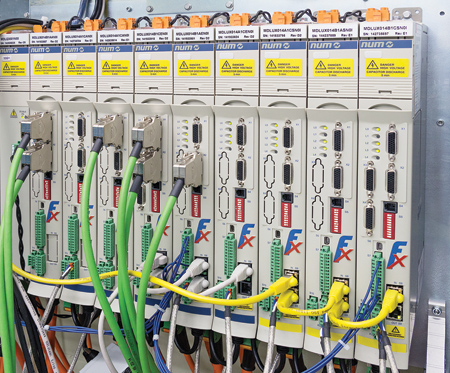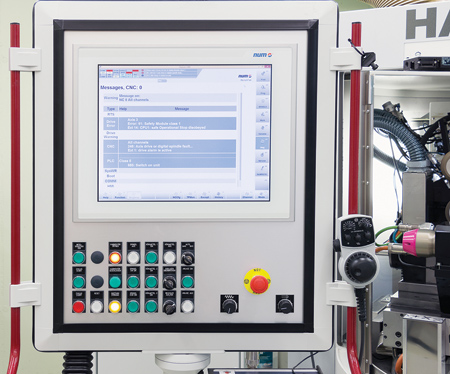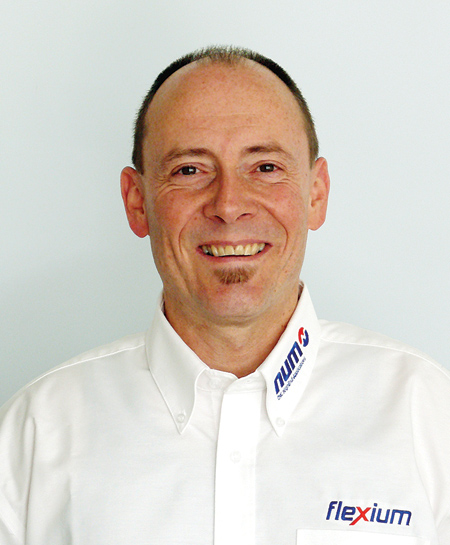


[NUMSafe provides CNC machine builders with a quick and easy means of implementing functional safety schemes to comply with legislation.

Peter Hutter, VP of Customer Solutions & Quality, NUM
"Implementing functional safety on new CNC machinery is an overriding trend in the metalworking machinery marketplace," said a company spokesperson. "One hundred percent of NUM's OEM customers who are developing new machines using its latest Flexium+ control platform are also adopting some level of functional safety. This change in technology is underpinning a growth rate of some 300% a year in the company's functional safety products, and NUM expects to see further growth during 2016."
"Functional safety is a pronounced design trend we see right now," said NUM's Peter Hutter, VP of Customer Solutions & Quality. "However, for our markets, it is invariably being implemented at the same time as new machines are developed. Existing machine ranges with earlier-generation safety schemes tend to be left as they are.
"For NUM, a fundamental element of the trend is ease of implementation, and the simplicity of safety programming is proving to be a catalyst. Functional safety is a complex subject and many of our customers are small to medium size companies, often with only one or two engineers that have PLC programming expertise. They frequently combine this work with other electrical and mechanical design roles, and they are not safety experts."
Techniques to simplify the design problem are critical enablers in this large sector of the machine building market, and this is the philosophy behind NUM's functional safety system, NUMSafe. Based on the use of a dedicated safety PLC, this solution is designed to reduce development complexity and the time required to implement safe motion functions compliant with standards such as EN ISO 13849-1 and EN 62061.
Introduced as a build-to-order option for NUM's Flexium+ CNC platform, NUMSafe is a complete functional safety solution that scales to suit the complexity of the machine control system. It includes a safety PLC, safety input and output (I/O) modules, digital servo drives with built-in safe motion monitoring facilities and compatible brushless servomotors. This system-wide architecture enables machine designers to include functional safety features where they are needed, with minimal additional components or wiring. "It provides a simple, cost-effective solution for all types of CNC applications - from basic 3-axis machines through to complex automation with 100-plus axes," said the spokesperson.
An increasing proportion of NUM's customers, principally in the machine manufacturing markets of Germany and Switzerland, have started to specify NUMSafe for new machine builds and CNC upgrades. Due to the rapid take-up during 2015, around 20% of the Flexium+ CNC systems that NUM ships now incorporate NUMSafe. The company expects this figure to rise substantially as high volume machine manufacturers in regions such as Asia seek to expand their business activities by exporting to overseas markets that are subject to rigorous safety legislation.
Peter Hutter said, "Many of our customers are niche players, with limited engineering resources. Until recently, they used third-party safety solutions, which could only partially be integrated into the machines' CNC control systems and often added many weeks of additional time to a machine's development cycle. By using NUMSafe, they are now able to implement fully integrated, standards-compliant safety schemes in a fraction of this time and with reduced cabling effort."
"For example, there are a number of recent applications involving CNC tool grinding machines - a market in which NUM has a strong presence," said the spokesperson. "Although the configuration of these machines varies from one manufacturer to another, they typically have at least five working axes (three linear and two rotary), each of which requires a variety of safe motion control functions. In nearly every case, NUMSafe has enabled customers to implement complete functional safety systems for their machines within a few days - and in some cases even in just a single day."
A common functional safety technique that is used to comply with the basic safe motion requirements of machinery safety standards such as EN ISO 13849-1 is the implementation of Safe Torque Off (STO) on appropriate axes. This function helps ensure that the drive or drives can no longer command motors to generate torque. The Safely-limited Speed (SLS) function can also be useful, especially when manual work needs to be performed on a machine with its doors open.
However, setting multi-axis machines to a safe state may also require specific axes to be driven to prescribed positions, or to satisfy other safety-related parameters, such as maintaining holding torque without moving. Also, each type of machine will have different protection devices - such as protective doors, interlock systems and light barriers - as well as a different structure in terms of its loading area, geometry of axes, etc. "These all require specific safety logic and specific safety functions for correct machine management. However, if the CNC system's PLC is involved it can lead to unnecessarily complex control schemes with redundant logic, causing significant additional set-up and programming overheads," said the spokesperson.
"NUMSafe overcomes these issues by using a dedicated safety PLC and clearly differentiating between standard and safety-related logic. Machine designers only need to implement safety functions that are pertinent to the task in hand, without worrying about extraneous functions for motion axes that are not involved in orderly shutdown routines," continued the spokesperson.
Another advantage of NUMSafe is that safe devices such as the safety PLC and safety I/O modules can be housed in the same standard terminal as other elements of the control system, helping to simplify integration. All communication between the machine's control system and servo drives is handled via EtherCAT field bus, using a Fail Safe over EtherCAT (FSoE) protocol to ensure the integrity of safety-related data.
The application program for the safety PLC is created using the same suite of software development tools that is used to commission the overall system, including CNC, PLC, drives and I/O modules. This unified development environment helps minimize learning time and reduce code generation overheads. The logic of the safety application is programmed using function blocks such as E-Stop, Operation Mode, AND, OR, etc., linked to safety inputs and outputs. Complex safety functions can be set up by chaining function blocks.
NUM's NUMDrive X digital servo drives, which are available in single- and dual-axis versions, offer an optional safe motion monitoring module that operates with the safety PLC to oversee and control all safety-related aspects of drive and motor behavior. This modular approach helps to reduce system costs, by allowing safety functions to be implemented on individual machine axes, and only where required.
There are two versions of safe motion monitoring modules, enabling designers to match their application needs. The basic module provides the STO function. The extended version also offers STO, as well as the additional EN 61800-5-2 compliant functions of Safe Operating Stop (SOS), Safe Stop 1 (SS1), Safe Stop 2 (SS2), SafelyLimited Speed (SLS), Safely-Limited Position (SLP) and Safe Direction Monitoring (SDM). Used singly or in combination, these functions help enable designers to embrace a range of machine safety concepts. They can all be implemented using either incremental or absolute encoders - apart from SLP, which requires safe homing and incremental encoders, or certified absolute encoders.
NUM also offers a range of compatible brushless servomotors. These include single-cable models developed specifically for use with NUMDrive X servo drives, which use a dedicated two-wire link embedded with the motor's power cable to carry power, position and redundant position feedback data to/from a safe digital encoder.
For more information contact:
Steve Schilling
NUM Corporation
603 East Diehl Road, Suite 115
Naperville, IL 60563
630-505-7722
sales.us@num.com
www.num.com